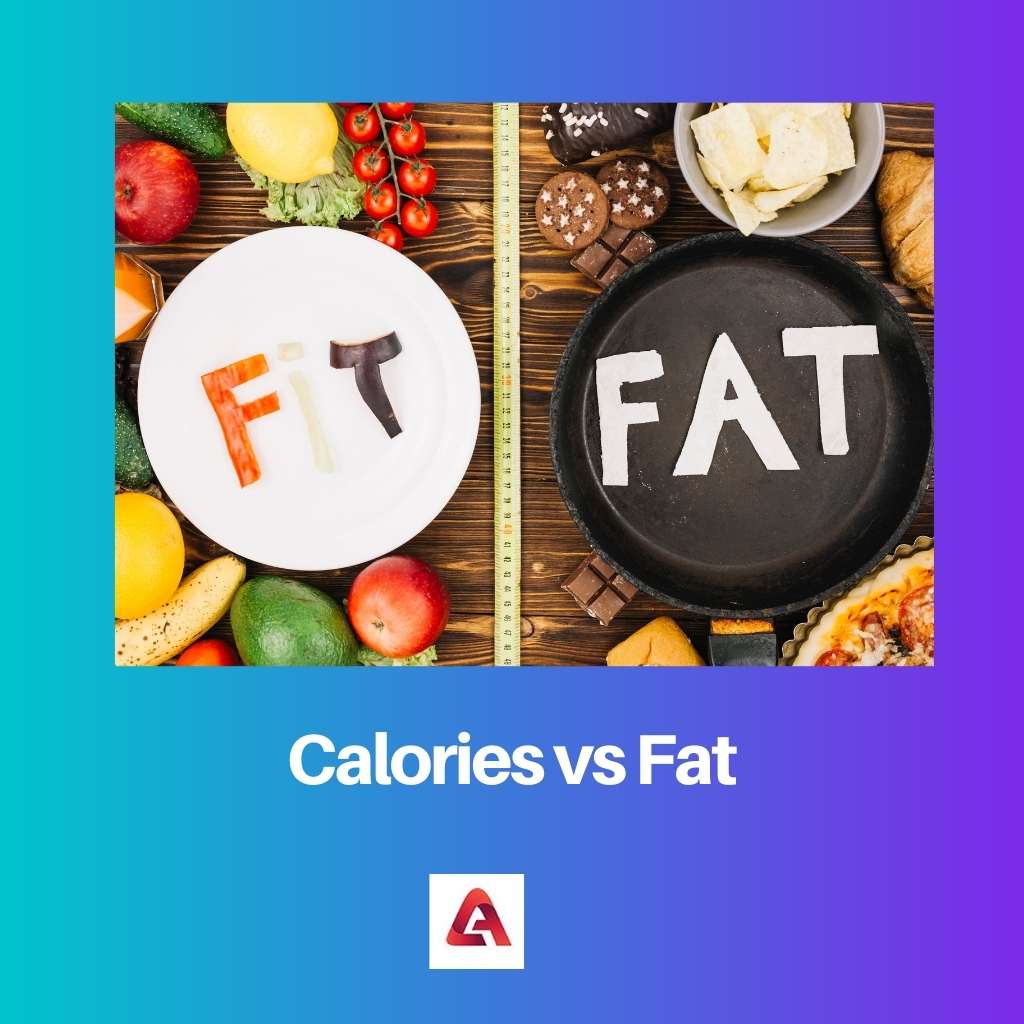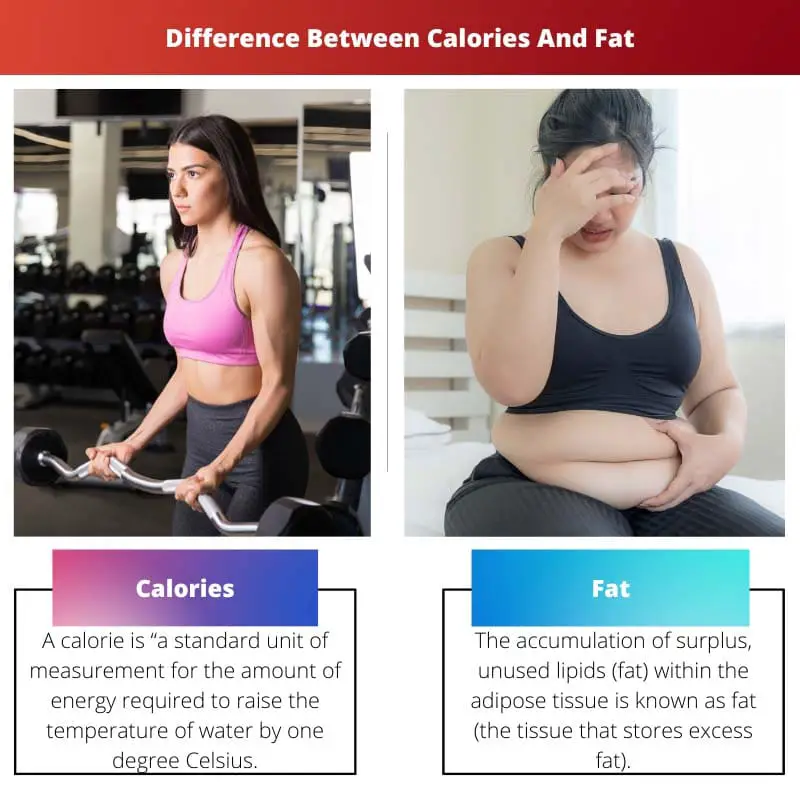People think calories and fat are under the same line. Knowing the difference between how calories and fats can function and where they get stored in our bodies can greatly change our food consumption pattern.
Key Takeaways
- Calories are a unit of energy used to measure the amount of energy food provides, while fat is a macronutrient that provides nine calories per gram.
- Consuming more calories than needed can lead to weight gain, regardless of whether they come from fat or other sources.
- Fat is essential for various bodily functions, including nutrient absorption and hormone production, but excessive fat intake can contribute to health issues.
Calories vs Fat
A calorie is a unit of energy that measures how much energy food provides to the body when metabolized. The body needs calories to work correctly. Fat is a nutrient in food that the body uses to build cell membranes, nerve tissue, and hormones. All fats contain calories, but not all calories have fat.

A calorie is “a standard unit of measurement for the amount of energy required to raise the temperature of water by one degree Celsius,” according to the Merriam-Webster definition. To get our daily calorie intake, we can divide your daily food consumption by six and multiply the quotient by 1000.
The accumulation of surplus, new lipids (fat) within the adipose tissue is known as fat (the tissue that stores excess fat). It arises due to a series of chemical events in the body’s normal cells to store fats that aren’t being used to store the fat right now.
Comparison Table
| Parameters of Comparison | Calories | Fat |
|---|---|---|
| Definition | Naturally, oily substances that are deposited underneath the skin as a layer around some organs and are primarily found in the tissues of animals and plants are known as fats. | The ideal and recommended fat intake per day should be between 44 grams and 77 grams. |
| Intake per day | For women from 1600 to 2400 and men between 2000 and 3000. | There are two categories of calories, and they are small calories and large calorie. |
| Digestion | A significant part of digestion happens only when the fat reaches the small intestine. | Fats are categorized into four: saturated fat, unsaturated fat, trans fat, and total fat. |
| Categories | The food groups that have significant calories sources are corn, beans, potato, and other food groups with significant calories sources. | The food groups with primary fat sources are butter, ghee, cream, cakes, biscuits, pastries, etc. |
| Food groups | The food groups with major fat sources are butter, ghee, cream, cakes, biscuits, pastries, etc. | The food groups with primary fat sources are butter, ghee, cream, cakes, biscuits, pastries, etc. |
What Are Calories?
As we all know, food is broken down in the body by mixing it with oxygen. It is burned up like fuel up to your will. This burning method also calculates how much work a power does.
The heat required to raise the temperature of one gram of water by one degree centigrade is called a “gram calorie.”
The difference between the “big calorie” and the “little calorie” is 1,000 times. The huge calorie is commonly used to determine the energy value of food.
Each food provides a specific quantity of calories as it “burns up.” One gram of protein, for example, has four calories, whereas one gram of fat contains nine.
The body doesn’t mind which energy is used as long as it gets enough from food to stay alive. The amount of calories the body requires is determined by the effort performed.
For example, if a man weighs 150 pounds and is entirely at rest, he only needs 1,680 calories daily.
This increases to 2,360 calories daily if he works moderately during the day. And if he works hard, he can need as many as 5,720 calories daily to keep his body running smoothly.
Because children are developing and burning many calories while playing, so they require more calories than adults.

What is Fat?
In biological substances, fats are commonly known as oils and lipids.
Saturated and unsaturated fats can be found in various meals, including proteins, carbohydrates, and dairy products.
Unsaturated fats have one or more double-bond chemical structures in their fatty acid chains.
These are the two different forms of unsaturated fats:
Mono-saturated: One double bond having two elements between them is known as mono-saturated fat.
Poly-saturated: These fats are thicker and have a double bond. The food groups containing these fats are fish, legumes, nuts, etc.
They appear healthy since they reduce the risk of heart disease and are essential to a well-balanced diet.
Another type of fat is trans fat, which is hydrogenated plant oils used to create synthetic greases.
They are found naturally in several foods, such as milk, and they are frequently connected to significant heart risks and health problems like liver dysfunction, heart disease, obesity, and cancer.
Cooking oils for fast food restaurants and fat substitutes are typical applications.
Fats high in saturated fats have double bonds or hydrogen “saturated” chains. Animal fat contains them. Cancer and other disorders have been linked to them.
Regarding fats, it is best to go for the healthier option. Polyunsaturated fats have been demonstrated to be more beneficial in general.

Main Differences Between Calories And Fat
- Calories have pre-SI metric energy units, whereas fats have fatty acid esters.
- The extra calories will be stored as body fat and extra fat will not be stored and will leave our body through the skin, kidneys, and lungs.
- Calories are broken down with the help of a food processing method also known as thermogenic while fats are broken down in the human body with the help of enzymes.
- The human body needs calories for the basic process and survival. On the other hand, the human body requires fat to support cell growth.
- Calories are quickly converted as fat within four to eight hours and fat is quickly formed in our waistline in less than four hours.

- https://www.psychiatrist.com/jcp/bipolar/impact-calories-fat-content-meals-oral-ziprasidone/
- https://www.degruyter.com/document/doi/10.1525/9780520952171/html
- https://books.google.com/books?hl=en&lr=&id=3wpHj3mvra8C&oi=fnd&pg=PP1&dq=what+are+fats&ots=c6EB-lRiC8&sig=9mbgHnL2Kf1GxcJalbv56AlinnE

A very informative article, a basic knowledge, but gold information.
I have learned so much from just reading this article.
This is great! I had no idea how important the difference between calories and fats are.
I believe it’s a very important distinction that should be taught to others.
This can help in maintaining a well-balanced diet. Very much appreciated.
Very complex, but very well explained.
Knowledge is power.
Interesting content. I believe this information is key to making mindful food choices for a healthier lifestyle.
And even for those who are on a diet.
This is not useful at all.
I think that knowing the difference can greatly change eating habits. I’m very satisfied with this reading.
I agree. Understanding calories and fats is crucial for those trying to lose weight.